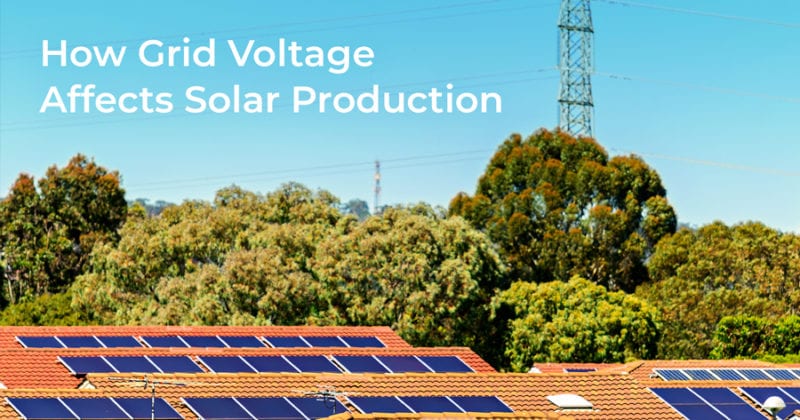How Grid Voltage Affects Solar Production

If you have a solar PV system installed and have been monitoring its production, you may have noticed your inverter’s power production reducing as it enters “Volt-Watt response mode” or shutting off all together due to an “over voltage” error. As long as your inverter has been installed in accordance with Australian Standards, these occurrences are part of the normal operation of the inverter and its interaction with the voltage on the local grid, and not due to a fault from the inverter.
Over Voltage Errors
The Australian Standard for grid connected solar inverters, AS 4777.2, states that an inverter must disconnect from the grid (i.e. shut down) if the voltage of the grid goes above 260V at any point in time, or if the average voltage over any 10 minute period goes above 255V. If your inverter has turned off and displays an “over voltage” error, it is due to one of these events occurring.
Power Reduction due to “Volt-Watt Response”
AS 4777.2 also states that inverters must reduce their maximum power output when the voltage of the grid exceeds 250V. The inverter does this by entering “Volt- Watt response mode” which essentially works by linearly reducing the inverter’s maximum power output by 5.3% for every volt over 250V, up to 265V where the inverter will eventually trip.
AS 4777.2 was introduced in October 2016, all new inverter installations must comply with this standard. If you have recently replaced your solar inverter and your old inverter was installed prior to the new Standard being introduced, you may not have experienced this issue before.
Cause of over voltage and power reduction
One of the mains cause of power reduction due to volt-watt response will most likely be seen in the middle of a sunny day when your system production is high, and your household consumption is low. Your system, likely along with lots of other systems in the local area, will be exporting excess solar generation the grid. For your inverter to export electricity to the grid, the voltage at your inverter must be slightly higher than the voltage at the grid to “push” the excess power to the grid. The higher the amount of electricity you are trying to export, the greater the “voltage rise” between your inverter and the grid will be. If the voltage at your inverter goes above 250V, the inverter will enter volt-watt response and reduce its maximum power output accordingly.
You are less likely to see this power reduction occurring if you household electricity demand is higher and you are utilising your solar production, rather than exporting it to the grid. If you aren’t utilising your solar production you might want to try and implement our suggestions in this blog in order to combat the issue.
Other causes
Over voltage trips and power reduction due to volt-watt response can also occur if the local electricity grid is operating outside of the nominal voltage that is required by Australian Standard AS 60038. AS 60038 states that the grid should operate at nominal 230V (measured at your home’s point of connection to the grid) with a variance of +10% to –6% (giving a range of 216.2V to 253V). If voltages above 253V are occurring your local grid operator should be contacted to reduce the voltage in your area (it is likely they will require evidence of the high voltage). They are normally able to achieve the voltage reduction by adjusting the local transformer.
Another cause of over voltage and power reduction occurs if your inverter has not been installed in accordance with AS 4777 “voltage rise” limits. The Standard states the voltage rise between your inverter and your home’s point of connection to the grid must not be more than 2%. All Infinite Energy’s installation teams conduct a voltage rise calculation (which is affected by cable lengths and thickness) prior to installation and ensure your inverter is installed in accordance with this voltage rise limit.
In conclusion
If the voltage on the grid is operating within the allowable range and your system has been installed with a maximum volt rise of 2%, other than reducing the amount of electricity you export to the grid (by increasing your household demand), there is very little that can be done to stop over voltage / power reduction occurring and it is an essential function of your inverter in order to maintain overall grid stability.


